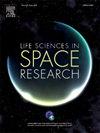x射线照射和饲养条件对马齿鱼线粒体的影响
IF 2.8
3区 生物学
Q2 ASTRONOMY & ASTROPHYSICS
引用次数: 0
摘要
具有挑战性的环境条件,如暴露于电离辐射,可以诱导线粒体内的氧化应激。然而,生物体在应对细胞压力的能力上表现出差异。本研究旨在确定住房条件如何影响辐射暴露下的线粒体应激反应。我们使用北美鹿鼠(Peromyscus maniculatus),将其饲养在标准啮齿动物箱或大型半自然围栏中,在环境大气条件下允许自然水平的身体活动和社会结构。每种饲养条件下的动物都暴露在2000毫西弗(2戈瑞)的电离x射线辐射下,这一剂量相当于长期太空飞行。在辐照前(基线)、辐照后4天内或辐照后1个月内对动物实施安乐死以进行分析。肝脏的相对质量低于在半自然围栏中饲养的受辐照动物的基线。状态4和偶联和不偶联状态3的肝脏和骨骼肌线粒体呼吸能力在暴露后4天降低。然而,暴露一个月后,这些变量在肌肉中与基线相当,但在肝脏中仍然较低。与基线相比,辐照后线粒体体积较低,而饲养在标准啮齿动物箱中的动物两种组织的线粒体体积均较高。关在笼子里的动物肝脏脂质氧化损伤程度更高,而关在半自然笼子里的动物肌肉脂质氧化损伤程度更高,而蛋白质氧化损伤程度没有变化。这些结果表明,具有更大活动潜力的异质环境可能抵消电离辐射的影响,尽管这种影响似乎不大。本文章由计算机程序翻译,如有差异,请以英文原文为准。
Effects of X-ray irradiation and housing conditions on mitochondria in Peromyscus maniculatus
Challenging environmental conditions, such as exposure to ionizing radiation, can induce oxidative stress within mitochondria. However, organisms show variation in their capacity to cope with cellular stress. This study aimed to identify how housing conditions influence mitochondrial stress responses under exposure to radiation. We used North American deer mice (Peromyscus maniculatus), kept in standard rodent boxes or large semi-natural enclosures that allowed for natural levels of physical activity and social structures under ambient atmospheric conditions. Animals from each housing condition were exposed to 2000 mSv (2 Gy) of ionizing X-ray radiation, a dose comparable to long-term spaceflight. Animals were euthanized for analysis prior to irradiation (baseline), within four days post-irradiation, or one-month following irradiation. Relative mass of the liver was lower than the baseline for irradiated animals maintained in the semi-natural enclosures. State 4 and coupled and uncoupled state 3 respiratory capacity of liver and skeletal muscle mitochondria were lower four days after the exposure. Yet, a month after exposure these variables were comparable to baseline in muscle but remained lower in the liver. The mitochondrial volume was lower after irradiation relative to baseline and was higher in animals maintained in standard rodent boxes, in both tissues. Oxidative damage to lipids in liver was higher in animals kept in boxes, whereas in muscle it was higher in animals kept in the semi-natural enclosures, and oxidative damage to proteins did not change. These results suggest that a heterogenous environment with greater potential for activity may counter the effects of ionizing radiation, although this effect appears to be modest.
求助全文
通过发布文献求助,成功后即可免费获取论文全文。
去求助
来源期刊

Life Sciences in Space Research
Agricultural and Biological Sciences-Agricultural and Biological Sciences (miscellaneous)
CiteScore
5.30
自引率
8.00%
发文量
69
期刊介绍:
Life Sciences in Space Research publishes high quality original research and review articles in areas previously covered by the Life Sciences section of COSPAR''s other society journal Advances in Space Research.
Life Sciences in Space Research features an editorial team of top scientists in the space radiation field and guarantees a fast turnaround time from submission to editorial decision.
 求助内容:
求助内容: 应助结果提醒方式:
应助结果提醒方式:


